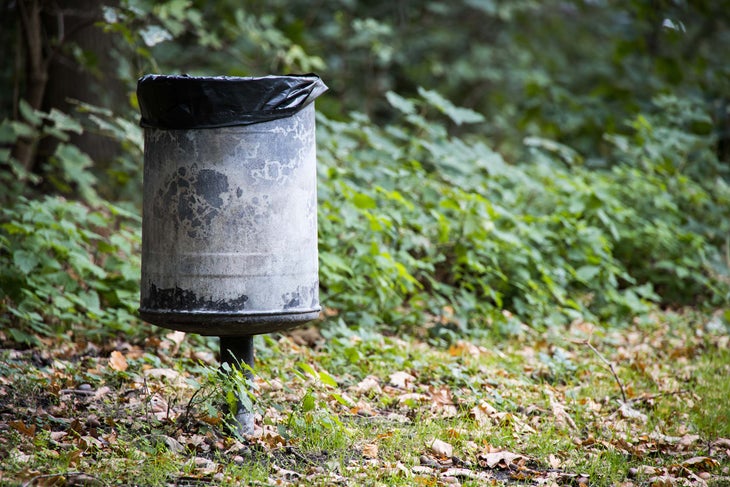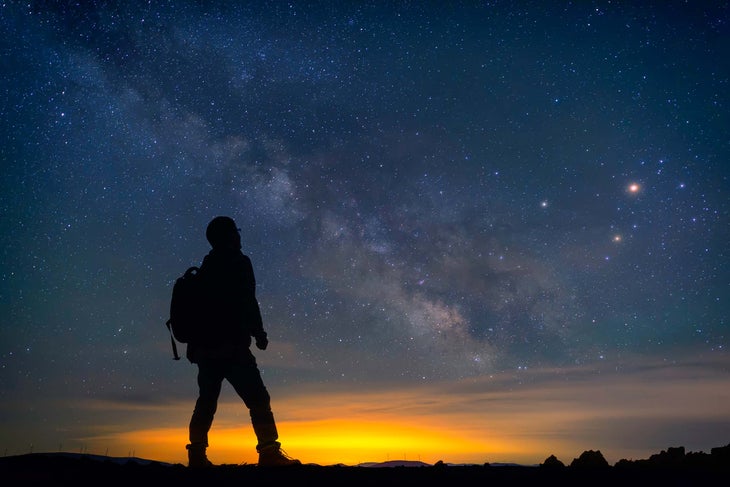Heading out the door? Read this article on the new Outside+ app available now on iOS devices for members! Download the app.
Backpacking is serious business, except when it’s not. Chuckle along in our twice-monthly humor column.
Editor’s Note: Backpacker is a proud proponent of Leave No Trace’s 7 principles, which help provide a set of guidelines for hikers to enjoy the wilderness while still preserving its beauty. But did you know that those aren’t the only Leave No Trace principles? Throughout its existence, Leave No Trace has declared a handful of other, mostly short-lived, rules. Check out these five precepts that didn’t stand the test of time and see what you think.
Take only bad photos…

Geotagged photos have a serious impact on the outdoors. Land managers are seeing hordes of visitors arriving at newly “Instagram-famous” destinations, leading to increased resource impacts, trash accumulation, and overcrowding. Instead of contributing to the problem, make your social media posts part of the solution by only geotagging terrible photos of your hikes so no one goes there. Instead of posting that secret Canyonlands lookout, where the colorfully striated rock looks like a blazing orange-and-pink sunset made stone, share a photo of the line to get into the park with a caption like “Ugh! This place is so crowded and also just blows chunks in general.” #HikingFails.” With every overflowing trash can from Mount Rainier or blurry squirrel from the Appalachian Trail that you post, you can take pride that you’re helping to preserve America’s natural heritage for future generations.
…leave only half as many footprints.
Generations of hikers have been told to “take only pictures and leave only footprints.” But the fact is that even our footfalls have an impact on the backcountry, wearing down trails and contributing to erosion. Still, hiking is all about walking, and Leave No Trace isn’t here to suck all the fun out of it—we’re reasonable people. All we ask is that you reduce the number of footprints you leave by carrying your hiking buddy the entire way. Hoist them piggyback style or sling them around your neck—how you do it is entirely up to you—and start trudging. Studies show that by carrying their partners, hikers can immediately cut their impact on the trail by half. If you’re struggling, consider getting stronger or finding smaller friends.
Want to further reduce your impact? Graduates of Leave No Trace’s awareness workshops learn to swing from tree to tree to avoid stepping on the ground at all; Leave No Trace Master Educators can even levitate through the power of their pure concern for the environment.
Camp on durable surfaces nowhere

Pitching your tent in sensitive areas can kill off plant life, creating packed-dirt scars that take years to heal. You can camp in impacted sites, but the fact is even the most established tent site used to be pristine. Get around this problem by simply never going to sleep: You can easily do “overnights” as marathon day hikes, covering 20 miles in a dawn-to-dusk push. For “weekend” and longer trips, dose yourself up with a copious amount of coffee, caffeine pills, or whichever other stimulant you prefer and hike nonstop until reality and dream begin to blend together and nightmarish, hallucinatory visions haunt every bend in the trail. If you absolutely must sleep, taking a short nap standing up against a mature tree is acceptable, as long as you sincerely apologize to the tree afterward.
Sabotage trail crews
“Leave No Trace” means exactly that. And you know who leaves the biggest trace on the wilderness, bigger than any stealth camper or ATV rider or illegal campfire-lighter? That’s right: the people who make trails. There are thousands of miles of trails winding through the forests and national parks of the United States, and each one of them is an abomination, a scar permanently etched into the face of Mother Earth. Even worse, millions of people hike on them every year, eliminating any chance that the areas had to regenerate naturally. Prevent further damage: find the equipment stashes that belong to the vandals who call themselves “trail crews” and steal all of their tools. Let’s see how good they are at hacking apart nature without their precious pick mattocks, pulaskis, and McLeods. If that doesn’t work, consider more drastic action, such as slashing their work trucks’ tires, organizing a protest at the trailhead, or taking the head of your local trail association hostage until they agree to your demands.
Walk without rhythm so you don’t attract the deadly sandworm Shai-Hulud

The desert’s harsh beauty draws millions of visitors every year, and a trip there can make memories that you’ll treasure forever. But the desert is also more fragile than many people realize, and if you’re going to hike there, there are a few things you need to keep in mind. Don’t step on biological soil crust, which prevents erosion and can take decades to regenerate. Use a wag bag and carry out all of your toilet paper. And above all, do not anger the massive, deadly sandworms called Shai-Hulud. Unlike bears, making noise won’t help you here—in fact, rhythmic noises seem to attract the worms, which reach 450 meters in length and can swallow a spice harvester whole. (One more reason not to use Bluetooth speakers!) To avoid attracting the worm, travel in small groups and remember to walk without rhythm, so your footsteps mimic the wind as it sweeps over the barren sands. Note: While riding Shai-Hulud may look like fun, please remember that this goes against Leave No Trace principles as well.
This is satire (except for the sandworm part, we stand by that.) Leave No Trace’s 7 Principles are pretty great. Get outside as often as you can—and follow the real ones.
From 2022
